Oldsmobile Aurora 1997 Owner's Manuals
Manufacturer: OLDSMOBILE, Model Year: 1997, Model line: Aurora, Model: Oldsmobile Aurora 1997Pages: 404, PDF Size: 20.75 MB
Page 291 of 404
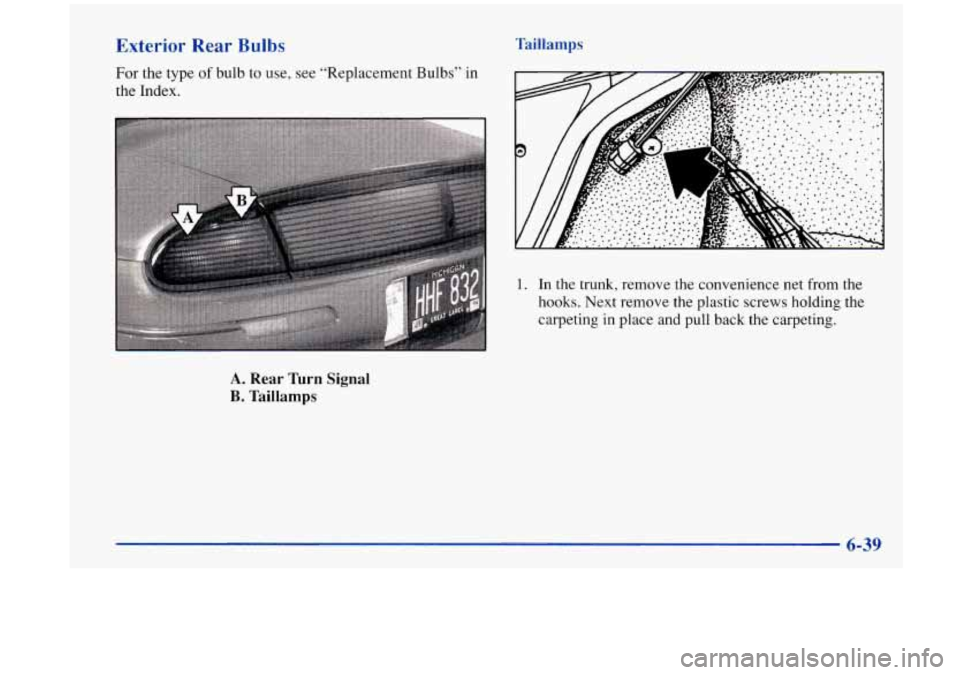
Exterior Rear Bulbs Taillamps
For the type of bulb to use, see “Replacement Bulbs” in
the Index.
1. In the trunk, remove the convenience net from the
hooks. Next remove the plastic screws holding the
carpeting
in place and pull back the carpeting.
A. Rear Turn Signal
B. Taillamps
6-39
Page 292 of 404

2. Unscrew the convenience net
attachment nut. Open
the trim panel door.
3. Remove the two wing
nuts now exposed. 4. Remove the taillamp filler screw located to the side
of the taillamp filler panel.
6-40
Page 293 of 404
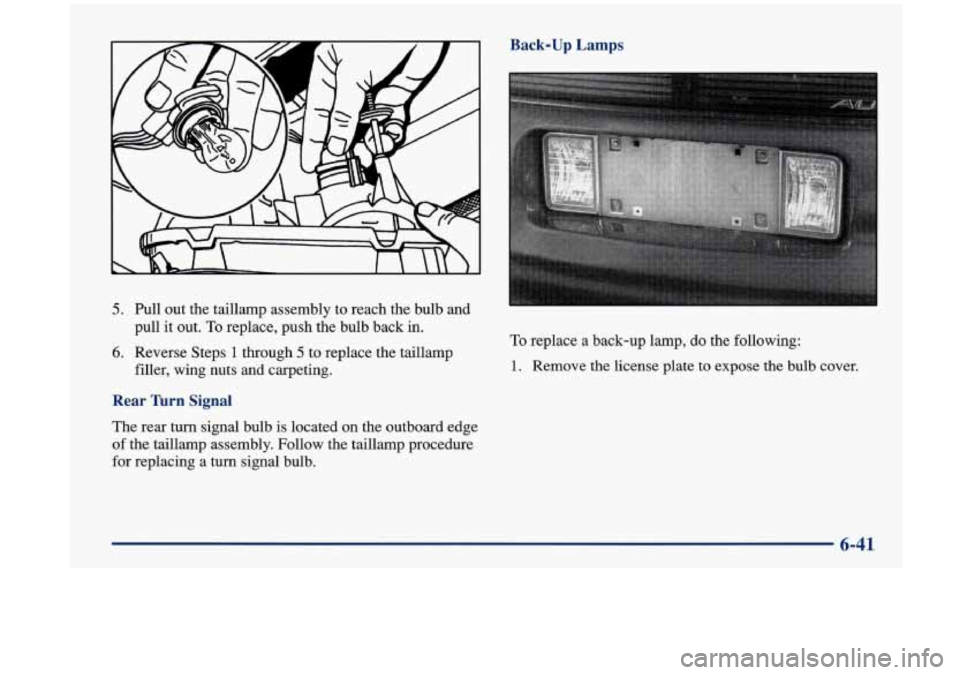
Back-up Lamps
5. Pull out the taillamp assembly to reach the bulb and
pull it out. To replace, push the bulb back in.
6. Reverse Steps 1 through 5 to replace the taillamp
filler, wing nuts and carpeting.
Rear Turn Signal
The rear turn signal bulb is located on the outboard edge
of the taillamp assembly. Follow the taillamp procedure
for replacing a turn signal bulb. To
replace
a back-up lamp, do the following:
1. Remove the license plate to expose the bulb cover.
6-41
Page 294 of 404

2. Use a 10 mm socket to
remove the four bolts.
There
are two bolts on
each side of the cover.
3. Pry off the cover and pull down to access the bulbs.
4. Press the locking tab of the bulb assembly.
6-42
Page 295 of 404

5. Twist the socket one-quarter of a turn
counterclockwise and pull to remove.
6. Replace the bulb and reverse Steps 1 through 4 to
replace the assembly and tighten the bolts.
Interior Lamps
Front and Rear Reading Lamps
To change the bulbs in the front and rear reading lamps,
do the following:
1. Carefully insert a flat head screwdriver in the slot
between
the lens cover and molding.
2. Gently pry the lens cover away to expose the reading
lamp bulb. The lens cover should pop off.
new bulb.
3. Remove the bulb from its assembly and install a
4. Snap the lens cover back in place.
Page 296 of 404
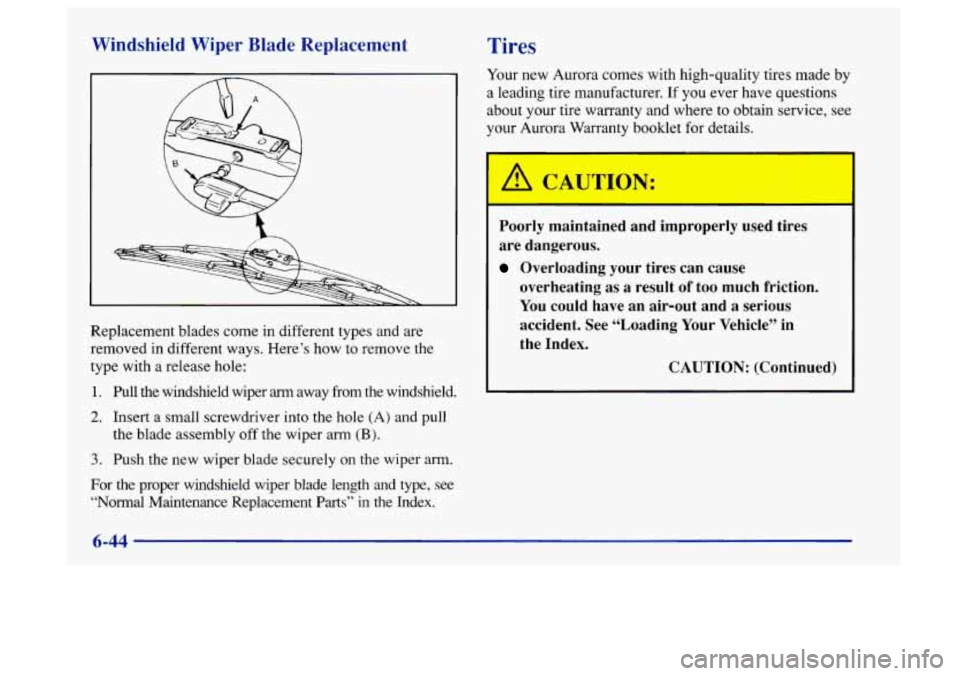
Windshield Wiper Blade Replacement
Replacement blades come in different types and are
removed in different ways. Here’s how to remove the
type with a release hole:
1. Pull the windshield wiper arm away from the windshield.
Tires
Your new Aurora comes with high-quality tires made by
a leading tire manufacturer.
If you ever have questions
about your tire warranty and where to obtain service, see
your Aurora Warranty booklet for details.
I
Poorly maintained and improperly used tires
are dangerous.
Overloading your tires can cause
overheating as a result of
too much friction.
You could have an air-out and a serious
accident. See “Loading Your Vehicle”
in
the Index.
CAUTION: (Continued)
2. Insert a small screwdriver into the hole (A) and pull
the blade assembly off the wiper arm
(B).
3. Push the new wiper blade securely on the wiper arm.
For the proper windshield wiper blade length
and type, see
“Normal Maintenance Replacement
Parts” in the Index.
6-44
Page 297 of 404
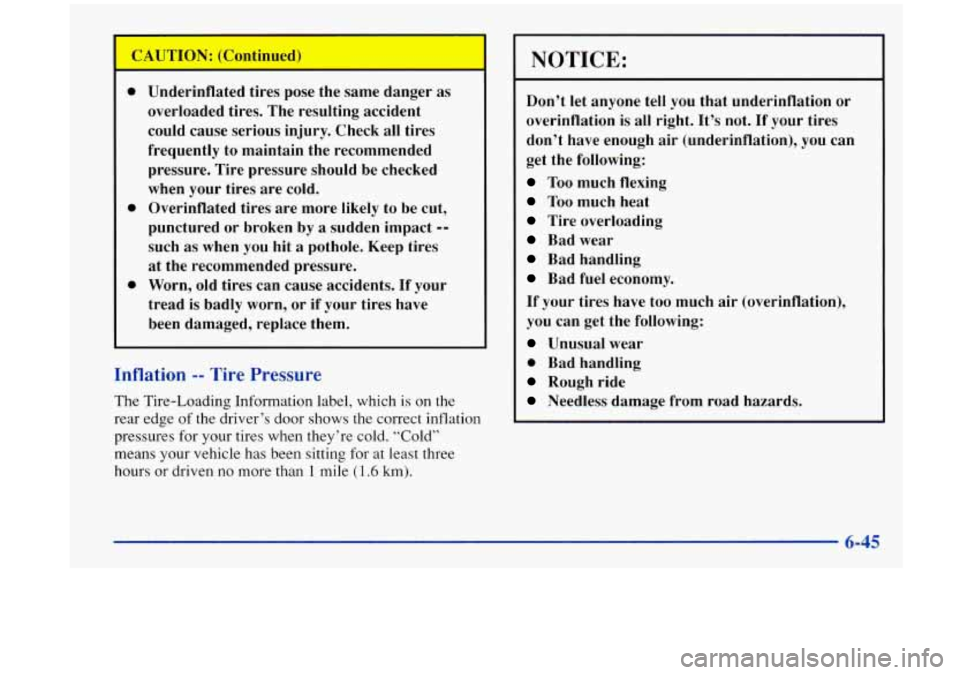
CAUTION: (Continued)
Underinflated tires pose the same danger as
overloaded tires. The resulting accident
could cause serious injury. Check all tires
frequently to maintain the recommended
pressure. Tire pressure should be checked
when your tires are cold.
Overinflated tires are more likely to be cut,
punctured or broken by
a sudden impact --
such as when you hit a pothole. Keep tires
at the recommended pressure. Worn, old tires can cause accidents.
If your
tread is badly worn, or
if your tires have
been damaged, replace them.
Inflation -- Tire Pressure
The Tire-Loading Information label, which is on the
rear edge of the driver’s door shows the correct inflation
pressures for your tires when they’re cold. “Cold’’
means your vehicle has been sitting for at least three
hours or driven
no more than 1 mile (1.6 km).
NOTICE:
Don’t let anyone tell you that underinflation or
overinflation
is all right. It’s not. If your tires
don’t have enough air (underinflation),
you can
get the following:
Too much flexing
Too much heat
Tire overloading
Bad wear
Bad handling
Bad fuel economy.
If your tires have too much air (overinflation),
you can get the following:
Unusual wear
0 Bad handling
Rough ride
Needless damage from road hazards.
6-45
Page 298 of 404
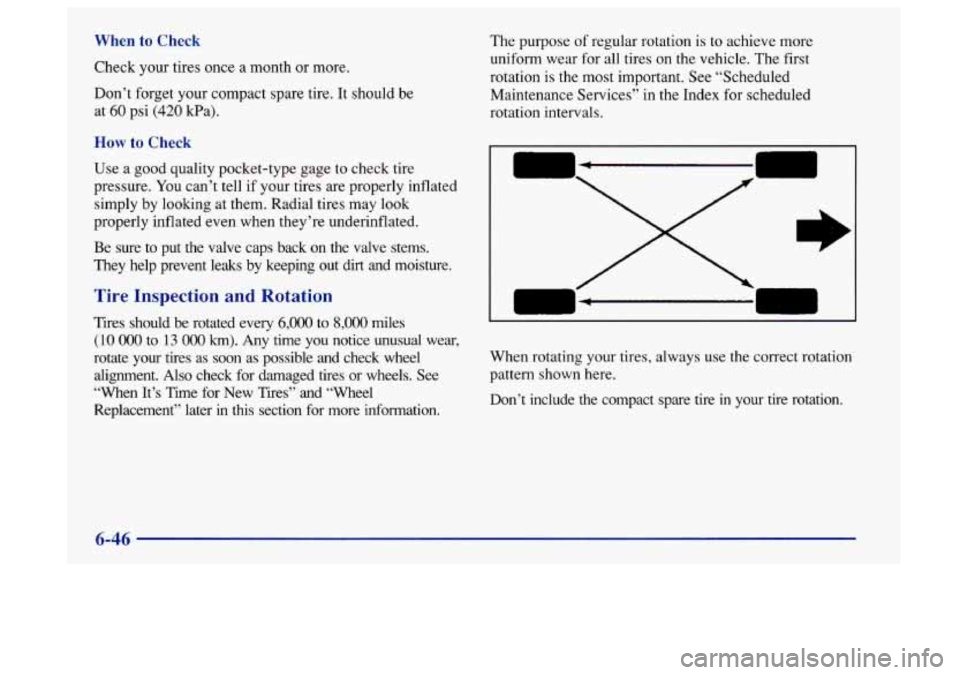
When to Check
Check your tires once a month or more.
Don’t forget your compact spare tire. It should be
at
60 psi (420 kPa).
How to Check
Use a good quality pocket-type gage to check tire
pressure. You can’t tell if your tires
are properly inflated
simply by looking at them. Radial tires may look
properly inflated even when they’re underinflated.
Be sure to put the valve caps back on the valve stems.
They help prevent leaks by keeping out dirt and moisture.
Tire Inspection and Rotation
Tires should be rotated every 6,000 to 8,000 miles
(10 000 to 13 000 km). Any time you notice unusual wear,
rotate your tires as soon as possible and check wheel alignment.
Also check for damaged tires or wheels. See
“When
It’s Time for New Tires” and “Wheel
Replacement’’ later
in this section for more information. The purpose
of regular rotation
is to achieve more
uniform wear for all tires on the vehicle. The first
rotation is the most important. See “Scheduled
Maintenance Services” in the Index for scheduled
rotation intervals.
When rotating your tires, always use the correct rotation
pattern shown here.
Don’t include
the compact spare tire in your tire rotation.
6-46
Page 299 of 404
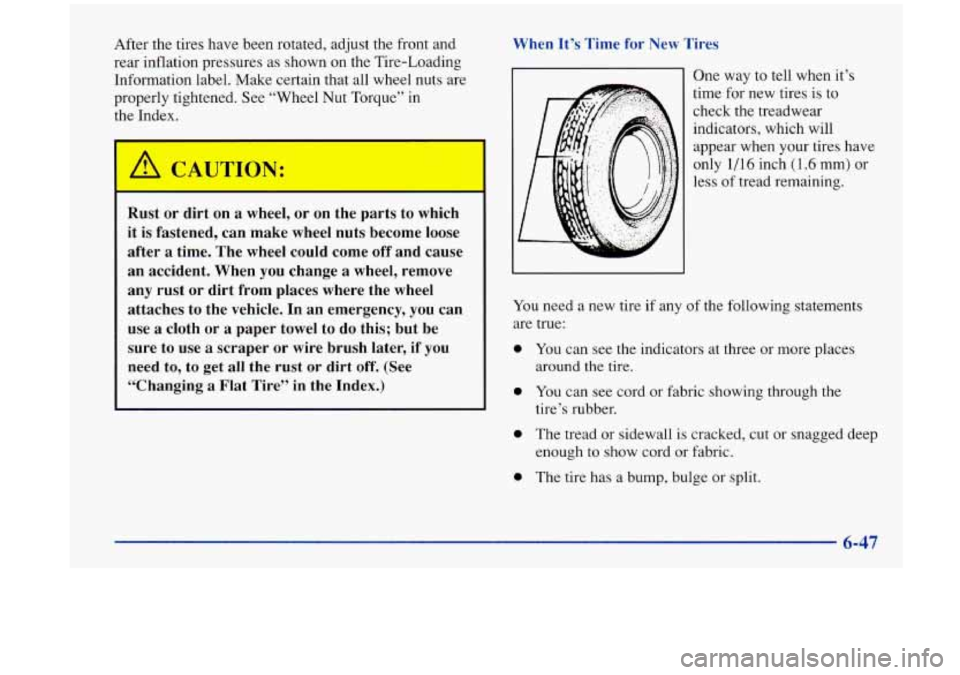
After the tires have been rotated, adjust the front and
rear inflation pressures as shown on the Tire-Loading
Information label. Make certain that all wheel nuts are
properly tightened. See “Wheel Nut Torque” in
the Index.
Rust or dirt on a wheel, or on the parts to which
it is fastened, can make wheel nuts become loose
after a time. The wheel could come off and cause
an accident. When you change
a wheel, remove
any rust
or dirt from places where the wheel
attaches to the vehicle.
In an emergency, you can
use
a cloth or a paper towel to do this; but be
sure
to use a scraper or wire brush later, if you
need to, to get
all the rust or dirt off. (See
“Changing
a Flat Tire” in the Index.) When
It’s Time for New Tires
r
L
I One way to tell when it’s
time for new tires is to
check the treadwear
indicators, which will
appear when your tires have
only
1/16 inch (1.6 mrn) or
less of tread remaining.
You need a new tire if any
of the following statements
are true:
0
0
0
0
You can see the indicators at three or more places
around
the tire.
You can see cord or fabric showing through the
tire’s rubber.
The tread
or sidewall is cracked, cut or snagged deep
enough to show cord or fabric.
The tire has a bump, bulge or split.
6-47
-
Page 300 of 404
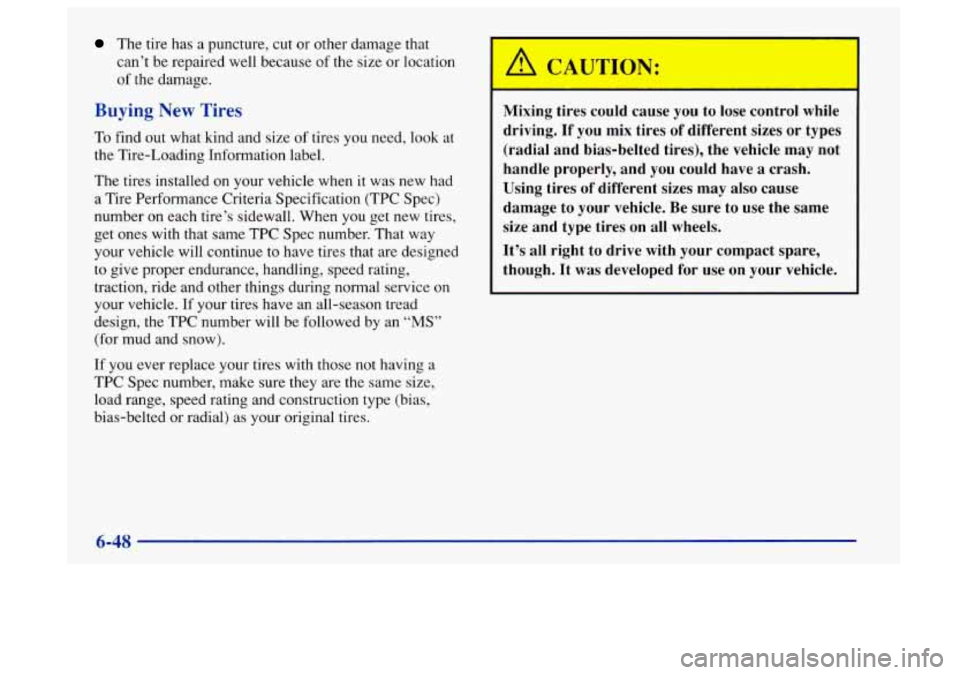
The tire has a puncture, cut or other damage that
can’t be repaired well because of the size or location
of the damage.
Buying New Tires
To find out what kind and size of tires you need, look at
the Tire-Loading Information label.
The tires installed on your vehicle when it was new had
a Tire Performance Criteria Specification (TPC Spec)
number on each tire’s sidewall. When you get new tires,
get ones with that same TPC Spec number. That way
your vehicle will continue to have tires that are designed
to give proper endurance, handling, speed rating,
traction, ride and other things during normal service on
your vehicle. If your tires have an all-season tread
design, the TPC number will be followed by an
“MS”
(for mud and snow).
If you ever replace your tires with those not having a
TPC Spec number, make sure they are the same size,
load range, speed rating and construction type (bias,
bias-belted or radial) as your original tires.
A CAUTION:
Mixing tires could cause you to lose control while
driving. If you mix tires of different sizes or types
(radial and bias-belted tires), the vehicle may not
handle properly, and you could have
a crash.
Using tires of different sizes may also cause
damage to your vehicle. Be sure to use the same
size and type tires
on all wheels.
It’s all right to drive with your compact spare,
though. It was developed for use on your vehicle.
6-48